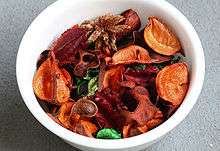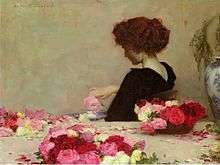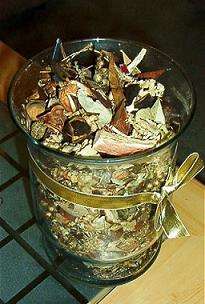Potpourri


Potpourri /ˌpoʊ pʊˈriː/ is a mixture of dried, naturally fragrant plant material, used to provide a gentle natural scent inside buildings, most commonly in residential settings. It is usually placed in a decorative (often wooden) bowl, or tied in small sachet made from sheer fabric.
Potpourri is used inside the home to give the air a pleasant smell. The word "potpourri" comes into English from the French word pot-pourri. The French term has two connotations. It is the French name for a Spanish stew with a wide variety of ingredients called "olla podrida," specialty of the town of Burgos. The word was taken and copied by the French military during the Napoleonic occupation of Burgos (1808-1813). Literally, however, the word pot in French has the same meaning as it does in Spanish and English, while the word pourri means rotten. In English, "potpourri" is often used to refer to any collection of miscellaneous or diverse items.
History
_-_Walters_48559.jpg)

Dried scented plant material has been used in rooms since ancient times, in a variety of ways, including just scattering them on floors. In early 17th Century France fresh herbs and flowers were gathered—starting in spring and continuing throughout the summer. The herbs were left for a day or two to become limp, then layered with coarse sea salt. The aging mixture was stirred occasionally as layers were added to it. Often the mixture would ferment or even mold as the summer went by. In fall, spices would be added to the unsightly grey mix until a pleasant fragrance was achieved, then scent preserving fixatives (see below) were added. The finished potpourri was set out in special pots with perforated lids to perfume rooms.
Much modern potpourri consists of any decoratively shaped dried plant material (not necessarily from scented plants) with strong natural and synthetic perfumes (and also often colored dyes) added, with the scent often bearing no relation to the plant material used. Sometimes, items that do not originate from plants are mixed in with the potpourri, to give it bulk and to make it more aesthetically pleasing. It is possible to spray scents onto potpourri, however a fixative is needed so that the scent is absorbed for slow release. Generally, orris root is used for this purpose.
Containers
In ceramics manufacturing, a potpourri vase is a vase specifically designed for holding potpourri. In the traditional designs a potpourri container is provided with a pierced fitted lid, through which the scent may slowly diffuse. The porcelain Sèvres pot-pourri vase in the shape of a ship is one of the most spectacular examples, from the 1750s and 1760s; Madame de Pompadour owned three of the 12 examples made, 10 of which survive.
Plants used

The number of plant species used in potpourri is large. Researchers have identified 300 species from 95 families, including fungi and lichens. A few toxic ingredients have been found, such as fruits from Strychnos nux-vomica, the strychnine tree. Naturally scented plants used in traditional potpourri include:
- allspice,
- cedar wood shavings (toxic, a moth repellent),
- cinnamon bark and cassia bark (smells like cinnamon only less potent)
- cloves,
- cypress wood shavings (toxic, a moth repellent),
- fennel seed,
- incense-cedar wood shavings
- jasmine flowers and oil,
- jujube flowers and blooms,
- juniper wood shavings (toxic, a moth repellent),
- lavender leaves and flowers,
- lemon balm leaves and flowers,
- lemon peel,
- marjoram leaves and flowers,
- mignonette leaves and flowers,
- mint leaves and flowers,
- mugwort (toxic, adds a musky note, a moth repellent)
- orange peel,
- pelargonium leaves from scented varieties,
- pinyon pine shavings and cones (seeds edible, bark toxic),
- rose flowers, hips, or oil,
- rosemary leaves and flowers,
References
| Look up potpourri in Wiktionary, the free dictionary. |
| Wikimedia Commons has media related to Potpourri. |